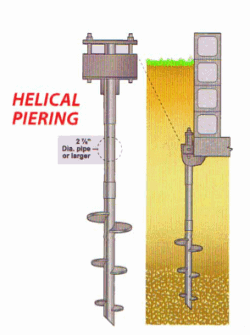To repair cracks in your foundation, the first step is ensuring that your house leans on soil that doesn’t sink. Our specialized helical pier solution eliminates a sinking foundation by anchoring it to solid soil found deep underground—providing a reliable and lasting sinking foundation repair.
.
Strategically Attached Helical Piers Anchor Your Foundation to More Stable Soil
Topsoil is less stable than the soil found deeper underground. A proven solution is to strategically attach helical piers to your sinking foundation and anchor them into more stable soil layers to stabilize the structure. Our trusted helical pier installation method ensures your foundation rests on secure footing.
In addition to foundation solutions, we also offer
crawl space encapsulation to protect your home from moisture, mold, and long-term structural damage.
 Our Quick and Simple Process:
Our Quick and Simple Process:
- Utility lines are marked in the working area
- A mini excavator digs beside the foundation to expose the footer
- Footer is cut and prepared for the helical pier bracket
- Helical piers are drilled down to load-bearing soil beside the footer at a controlled pitch
- Lead and extension shafts transmit torque during installation and transfer the axial load to the helical plate(s)
- Repair bracket is attached to the foundation and connected to the helical pier
- Jack stand is attached to the helical piers system to lift the foundation, transferring load to helical plates in load-bearing soil
- Job site backfilled and cleaned up
Request A Free Quote
We strive to answer your questions so you’re comfortable and understand the work to be done.
Get a Quote
Common Questions
Is the helical pier the best option for my sinking foundation?
Yes! There are two types of piers in the industry.
1. The Push Pier
The push pier system uses the weight of the existing foundation to push steel pipes down into more stable soil conditions. However, once the foundation starts to lift from pushing the pier into the soil, the installer has to stop at that point. The push pier may or may not reach solid soil. If extra weight is added to your home (like snow on the roof), the push pier may fail—requiring additional sinking foundation repair. Many companies still use push piers because the material is less expensive and installation requires no equipment, leading to higher profit margins.
2. The Helical Pier
Helical pier failure is nearly unheard of because helical piers are drilled into load-bearing soil using a drive head drill attached to a mini excavator. Once the helical pier shaft reaches the required pressure, we know it’s securely installed and ready to handle all load conditions. That’s why Forever Foundation Repair uses helical piers for all helical pier installation and sinking foundation repair projects.
Can the foundation move after helical piers are installed?
No, once Forever Foundation Repair installs helical piers to stabilize your foundation it cannot sink or move anymore.
How deep are helical piers installed?
In most cases, helical piers go 14 to 28 feet deep. However, in areas with less stable soil—especially around lakes like Lake Erie, Crooked Lake, or Indian Lake—the helical pier installation may require drilling 50 to 70 feet deep to reach load-bearing strata.
Will you be able to lift the foundation back into place, level doors, windows and close cracks in drywall and brick veneer?
In most cases, yes. The foundation is leveled, allowing cracks to close and doors to function properly. However, the primary goal of sinking foundation repair is to lift and stabilize the structure, relieving stress from the home.
How long is the warranty for helical piers?
Forever Foundation Repair warranties our helical piers for the life of the home, ensuring lasting peace of mind and structural integrity.
How long does it take to fix my foundation with helical piers?
The most common sinking foundation repair jobs take one to two days, depending on the size of the project and soil conditions.
Is this a common problem?
Yes, sinking foundation repair and helical pier installation are part of our everyday services at Forever Foundation Repair. If you’re having issues, chances are some of your neighbors are experiencing similar problems.
Does homeowners insurance cover a sinking foundation?
No, homeowners insurance typically does not cover sinking foundation repair. That’s why it’s important to address signs of settlement as soon as possible.
Isn’t settling in a foundation normal?
Minor settling is common, but if you notice cracks in drywall or brick veneer, your foundation may be sinking. These are early warning signs that should be addressed with a home inspection and professional helical pier installation.
The contractor who built my house didn’t know what he was doing. Is that why my foundation is sinking?
In most cases, poor construction isn’t the issue. Changing soil conditions and water movement are the primary causes of foundation movement and settling.
My house has been here for 40 years, why is it moving now?
It doesn’t matter if your home is new or decades old. Soil hydrology constantly changes, which is a common cause of sinking foundation repair needs—even in long-standing homes.
What if I don’t fix the sinking foundation?
Ignoring a sinking foundation is never a good idea. It can lead to severe damage such as:
- Cracked trusses
- Brick or siding damage
- Torn electrical wiring
- Broken plumbing
- Roof leaks
It’s essential to schedule a professional sinking foundation repair before the damage worsens!
 Our Quick and Simple Process:
Our Quick and Simple Process: